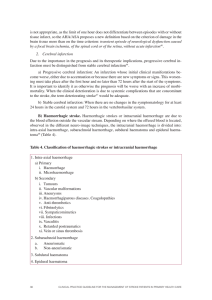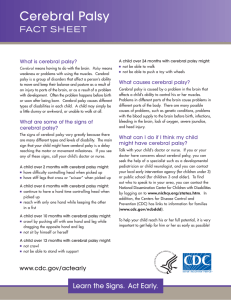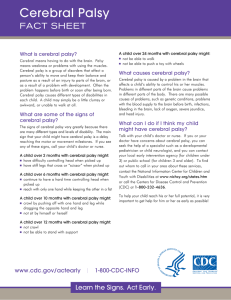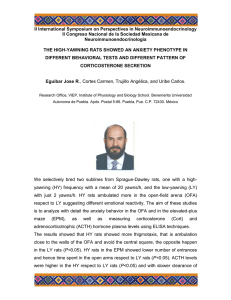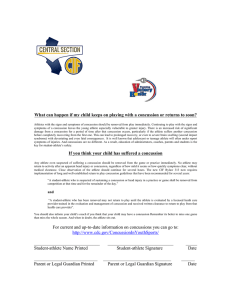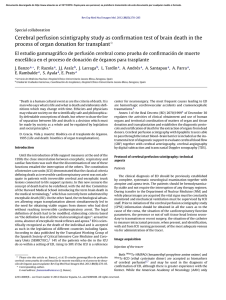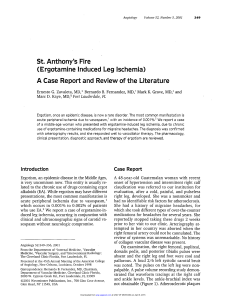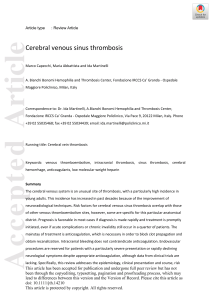Therapeutic potential of the novel hybrid molecule JM
Anuncio
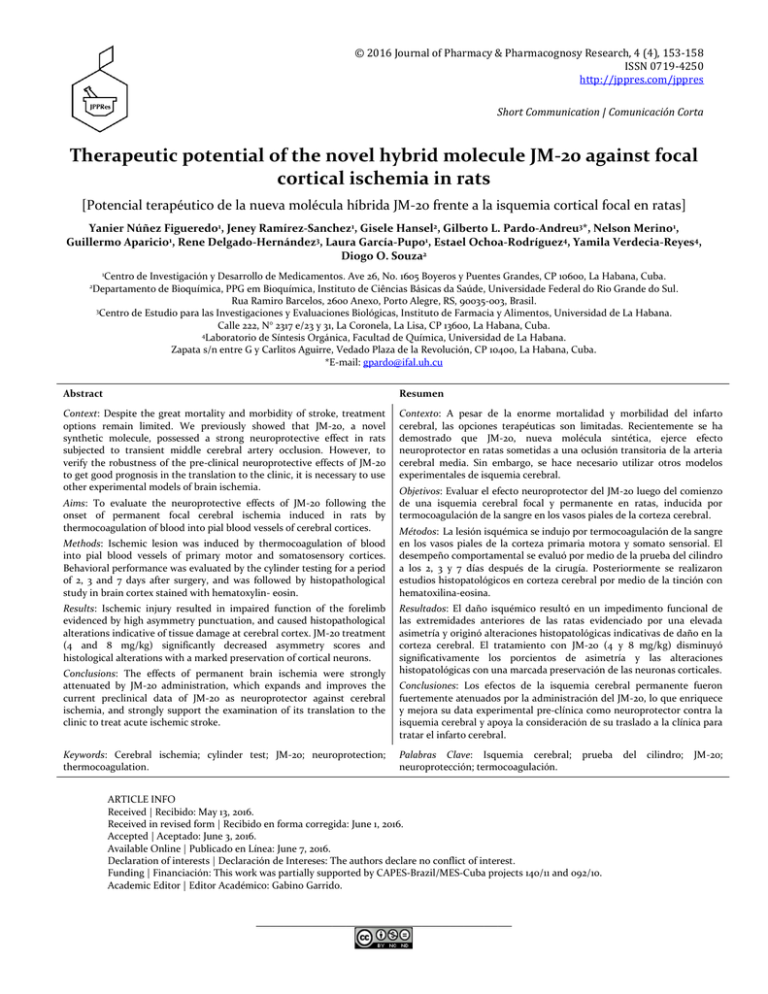
© 2016 Journal of Pharmacy & Pharmacognosy Research, 4 (4), 153-158 ISSN 0719-4250 http://jppres.com/jppres Short Communication | Comunicación Corta Therapeutic potential of the novel hybrid molecule JM-20 against focal cortical ischemia in rats [Potencial terapéutico de la nueva molécula híbrida JM-20 frente a la isquemia cortical focal en ratas] Yanier Núñez Figueredo1, Jeney Ramírez-Sanchez1, Gisele Hansel2, Gilberto L. Pardo-Andreu3*, Nelson Merino1, Guillermo Aparicio1, Rene Delgado-Hernández3, Laura García-Pupo1, Estael Ochoa-Rodríguez4, Yamila Verdecia-Reyes4, Diogo O. Souza2 1Centro de Investigación y Desarrollo de Medicamentos. Ave 26, No. 1605 Boyeros y Puentes Grandes, CP 10600, La Habana, Cuba. Departamento de Bioquímica, PPG em Bioquímica, Instituto de Ciências Básicas da Saúde, Universidade Federal do Rio Grande do Sul. Rua Ramiro Barcelos, 2600 Anexo, Porto Alegre, RS, 90035-003, Brasil. 3Centro de Estudio para las Investigaciones y Evaluaciones Biológicas, Instituto de Farmacia y Alimentos, Universidad de La Habana. Calle 222, N° 2317 e/23 y 31, La Coronela, La Lisa, CP 13600, La Habana, Cuba. 4Laboratorio de Síntesis Orgánica, Facultad de Química, Universidad de La Habana. Zapata s/n entre G y Carlitos Aguirre, Vedado Plaza de la Revolución, CP 10400, La Habana, Cuba. *E-mail: gpardo@ifal.uh.cu 2 Abstract Resumen Context: Despite the great mortality and morbidity of stroke, treatment options remain limited. We previously showed that JM-20, a novel synthetic molecule, possessed a strong neuroprotective effect in rats subjected to transient middle cerebral artery occlusion. However, to verify the robustness of the pre-clinical neuroprotective effects of JM-20 to get good prognosis in the translation to the clinic, it is necessary to use other experimental models of brain ischemia. Contexto: A pesar de la enorme mortalidad y morbilidad del infarto cerebral, las opciones terapéuticas son limitadas. Recientemente se ha demostrado que JM-20, nueva molécula sintética, ejerce efecto neuroprotector en ratas sometidas a una oclusión transitoria de la arteria cerebral media. Sin embargo, se hace necesario utilizar otros modelos experimentales de isquemia cerebral. Aims: To evaluate the neuroprotective effects of JM-20 following the onset of permanent focal cerebral ischemia induced in rats by thermocoagulation of blood into pial blood vessels of cerebral cortices. Methods: Ischemic lesion was induced by thermocoagulation of blood into pial blood vessels of primary motor and somatosensory cortices. Behavioral performance was evaluated by the cylinder testing for a period of 2, 3 and 7 days after surgery, and was followed by histopathological study in brain cortex stained with hematoxylin- eosin. Results: Ischemic injury resulted in impaired function of the forelimb evidenced by high asymmetry punctuation, and caused histopathological alterations indicative of tissue damage at cerebral cortex. JM-20 treatment (4 and 8 mg/kg) significantly decreased asymmetry scores and histological alterations with a marked preservation of cortical neurons. Conclusions: The effects of permanent brain ischemia were strongly attenuated by JM-20 administration, which expands and improves the current preclinical data of JM-20 as neuroprotector against cerebral ischemia, and strongly support the examination of its translation to the clinic to treat acute ischemic stroke. Keywords: Cerebral ischemia; cylinder test; JM-20; neuroprotection; thermocoagulation. Objetivos: Evaluar el efecto neuroprotector del JM-20 luego del comienzo de una isquemia cerebral focal y permanente en ratas, inducida por termocoagulación de la sangre en los vasos piales de la corteza cerebral. Métodos: La lesión isquémica se indujo por termocoagulación de la sangre en los vasos piales de la corteza primaria motora y somato sensorial. El desempeño comportamental se evaluó por medio de la prueba del cilindro a los 2, 3 y 7 días después de la cirugía. Posteriormente se realizaron estudios histopatológicos en corteza cerebral por medio de la tinción con hematoxilina-eosina. Resultados: El daño isquémico resultó en un impedimento funcional de las extremidades anteriores de las ratas evidenciado por una elevada asimetría y originó alteraciones histopatológicas indicativas de daño en la corteza cerebral. El tratamiento con JM-20 (4 y 8 mg/kg) disminuyó significativamente los porcientos de asimetría y las alteraciones histopatológicas con una marcada preservación de las neuronas corticales. Conclusiones: Los efectos de la isquemia cerebral permanente fueron fuertemente atenuados por la administración del JM-20, lo que enriquece y mejora su data experimental pre-clínica como neuroprotector contra la isquemia cerebral y apoya la consideración de su traslado a la clínica para tratar el infarto cerebral. Palabras Clave: Isquemia cerebral; neuroprotección; termocoagulación. prueba ARTICLE INFO Received | Recibido: May 13, 2016. Received in revised form | Recibido en forma corregida: June 1, 2016. Accepted | Aceptado: June 3, 2016. Available Online | Publicado en Línea: June 7, 2016. Declaration of interests | Declaración de Intereses: The authors declare no conflict of interest. Funding | Financiación: This work was partially supported by CAPES-Brazil/MES-Cuba projects 140/11 and 092/10. Academic Editor | Editor Académico: Gabino Garrido. _____________________________________ del cilindro; JM-20; Núñez Figueredo et al. Neuroprotective effect of JM-20 against brain ischemia INTRODUCTION MATERIAL AND METHODS Stroke is defined as a sudden neurological deficit caused by impairment in blood flow to the brain (Onteniente et al., 2003). Its impact on human and economic toll is tremendous. The growing understanding of the mechanism of cell death in ischemia leads to new approaches in stroke treatment. Nevertheless, the applicability of results obtained from animal models to the treatment of human diseases has been limited, as occurred with neuroprotection (Casals et al., 2011). Due to the multiplicity of mechanisms involved in causing neuronal damage during ischemia, an emerging paradigm in the development of novel therapeutics advocates the deliberate search for agents acting as multiple ligands or multifunctional drugs (Cavalli et al., 2008). JM-20 (3-ethoxycarbonyl-2methyl-4-(2-nitrophenyl)-4, 11-dihydro-1H-pyrido [2,3-b] [1,5] benzodiazepine) is a novel benzodiazepine derivate with potent anti-ischemic effect in rats subjected to transient middle cerebral artery occlusion (MCAOt) (Nuñez-Figueredo et al., 2014a). Studies are pointing that JM-20 may exert its effects through a multimodal way that involve potent antioxidant and anti-calcic effects, both elicited at mitochondrial level (Nuñez-Figueredo et al., 2014a, 2014b, 2014c); and by modulation of glutamatergic and immunological systems, particularly in astrocytes (Nuñez-Figueredo et al., 2015; Ramírez-Sánchez et al., 2015). These results, together with the apparent lack of toxicity of JM-20 evidenced by the absence of toxic signs after an oral dose of 2000 mg/kg (Figueredo et al., 2013), prompted us to continue with its pharmacological development. According to the preclinical recommendations for the development of a neuroprotective drug, the efficacy studies should also be performed in ischemic animals exposed to permanent occlusion interventions (Fisher, 2011). Obviously, the larger and dissimilar of succeeded preclinical experiences of neuroprotection, the better anticipation of positive outcomes in clinical translation. Thus the objective of this study was to investigate the potential neuroprotective role of JM-20 using a model of permanent focal cerebral ischemia induced by thermocoagulation. Synthesis and chemical characterization of JM20 http://jppres.com/jppres JM-20 was synthesized, purified and characterized as previously reported (Figueredo et al., 2013). Animals Adult male Wistar rats (CENPALAB, Havana, Cuba) weighing 275-300 g were housed in the animal care facility for one week prior to in vivo experiments. Rats (arranged 3-5 per cages) were kept in a temperature-controlled room (22 ± 2 °C) with a 12 h light/dark cycles and free access to food and water. Animal housing and care and all experimental procedures were in accordance with institutional guidelines under approved animal protocols (Animal Care Committee of CIDEM, Havana, Cuba). All efforts were made to minimize the number of animals used and to prevent suffering. Induction of permanent focal ischemia Ischemic lesion was induced by thermocoagulation of blood into pial blood vessels of primary motor and somatosensory cortices (de Vasconcelos Dos Santos et al., 2010). Anesthesia was induced with ketamine/xylazine (75/8 mg/kg) administered intraperitoneally. Briefly, the rats were placed in a stereotaxic apparatus and the skulls were surgically exposed. Craniotomies were performed, exposing the left frontoparietal cortex (+2 to 26 mm A.P. and 22 to 24 mm M.L. from bregma), the motor and sensorimotor cortex regions. Blood in the pial vessels was thermocoagulated transdurally by approximation of a hot probe to the Dura mater. The development of a dark red color was an indicator of complete thermocoagulation. After the procedure, the skins were sutured and body temperatures were maintained in the normal range (36.5°C to 37.5°C) until recovery from the anesthesia. JM-20 treatments Animals were randomly divided into 5 experimental groups (n= 8): (1) Sham-vehicle, (2) Ischemia-vehicle, (3) Ischemia-JM-20 (2 mg/kg), (4) Ischemia-JM-20 (4 mg/kg), and (5) Ischemia-JM-20 (8 J Pharm Pharmacogn Res (2016) 4(4): 154 Núñez Figueredo et al. mg/kg). The JM-20 doses were chosen based on previous neuroprotective effects reported elsewhere (Nuñez-Figueredo et al., 2014a). The animals were administered with JM-20 or vehicle by oral gastric gavage one hour after surgical interventions and during six consecutive days. The dissimilarities in the dosing volumes were alleviated by correcting the concentration to ensure a constant volume (10 mL/kg). Immediately before use, JM-20 was suspended in a 0.05% carboxymethyl cellulose solution (vehicle). Cylinder test The functional outcome was evaluated using the cylinder test that exposes forelimb preference when the animal rears to explore its environment by making forelimb contact with the cylinder walls. To prevent habituation to the cylinder, the number of movements recorded was limited to 20. The occurrences of sole use of the ipsilateral (to the lesion) or contralateral forelimb, or the simultaneous use of both forelimbs, were counted and the asymmetry score was calculated by the formula previously described (de Vasconcelos Dos Santos et al., 2010). Animals in all groups were tested one day before the ischemia and at post-ischemic days 2, 3 and 7. After the last evaluation, the brains of the animals were dissected for histopathological study. Histopathology Animals (n = 8 for each group) were anesthetized and transcardially perfused with ice-cold 0.9% saline for 10 min and then for 15 min with 4% paraformaldehyde in 0.1 mmol/L phosphate buffer. Animals were decapitated, and the brains were allowed to post-fix overnight in 4% paraformaldehyde. Brains were embedded in paraffin, sliced in 5 mm thick coronal sections of different cerebral regions and processed for hematoxylin and eosin (H&E). In the hemisphere ipsilateral to the ischemic insult, a light microscope BR044 (Carl Zeiss) with an immersion objective lens (40 × ) and a large-field ocular lens (8 ×) was used to measure the cortical normal and damaged neurons from sham-operated, vehicle- or JM-20-treated brains. Cells showing atrophy, shrinkage, nuclear pyknosis, dark cytoplasmic coloration or ambient empty spaces all indicated cell degeneration (Bian et al., 2007). An ocular grid with a square side of 130 µm in the ocular lens was http://jppres.com/jppres Neuroprotective effect of JM-20 against brain ischemia used to count the total numbers of normal and pathological neurons in each fixed cortical region using ImageJ 1.41 (National Institutes of Health, USA). Cell counts were expressed as a percentage of the sham group. Statistical analysis The software program GraphPad Prism 5.0 (GraphPad Software Inc., USA) was used. The data were expressed as the mean ± SEM. Comparisons between the different groups were performed by the one-way analysis of variance (ANOVA) followed by the Newman–Keuls multiple comparison tests. Differences were considered statistically significant at p<0.05. RESULTS JM-20 treatment fully restored function of the impaired forelimbs Fig. 1 shows that the oral administration of JM20 decreased significantly the asymmetry score in a doses-dependent manner (p<0.05) with respect to ischemic group in all evaluation sections. JM-20 at 8 mg/kg elicited similar asymmetric profile than the sham group indicating fully restoration of the impaired forelimbs function. JM-20 treatment reduced ischemia-induced histopathological damage H&E staining showed histological changes in cortical regions of injured brains (ischemia-vehicle) including shrunken cells with condensed and triangulated-pyknotic nuclei surrounded by swollen cellular process and cytoplasmic eosinophilia (Fig. 2A). In contrast, normal tissue patterns were observed in cortical sections from sham animals (Sham). JM-20 (4 and 8 mg/kg) inhibited the ischemia induced damage in cortical sections (Fig. 2A). The most important histological signs of neuroprotection elicited by JM-20 treatment were the preservation of cortical neurons. In this sense, Fig. 2B shows a significant decrease (p<0.05) in injured cortical neurons when animals were treated with 4 and 8 mg/kg JM20 compared with the vehicle group. J Pharm Pharmacogn Res (2016) 4(4): 155 Núñez Figueredo et al. Neuroprotective effect of JM-20 against brain ischemia 100 Asymmetry (%) Sham-vehicle Ischemia-vehicle 75 Ischemia-JM-20 (2 mg/kg) 50 * * * * 48 h 72 h 25 * Ischemia-JM-20 (4 mg/kg) Ischemia-JM-20 (8 mg/kg) * 0 0h 7 days Figure 1. Recovery from the ischemiainduced forelimb impairment in the cylinder tests before (0 h), 2 (48 h), 3 (72 h) and 7 days after surgery. Results showed the forelimb preference of shamvehicle, ischemia-vehicle, and ischemiaJM-20 (2, 4 and 8 mg/kg) treated groups. JM-20 (or vehicle) was orally administered at a therapeutic scheme during six consecutive post-ischemic days, beginning at day one, 1 h after surgery. Data are expressed as percentage of asymmetry score of the group (n = 8) ± SEM. *P<0.05 versus vehicle treated group. A Sham Vehicle JM-20 (2 mg/kg) JM-20 (4 mg/kg) JM-20 (8 mg/kg) Cell counts (% of vehicle) B b c 100 d 50 e a 0 am Sh le Ve hic http://jppres.com/jppres 2 4 JM-20 (mg/kg) 8 Figure 2. Histological evaluation (hematoxylin -eosin staining) of the post-ischemic effects of acute JM-20 treatment. The panels show representative images (A) and morphometric analysis of cortical regions (B) of the sham-operated, vehicle-, and JM-20-treated animals seventh days after ischemic damage. In the vehicle treated animals the morphological evidences of neuronal damage were identified as follow: arrows () shrunken neurons, head arrows () triangulated-pyknotic nuclei, and rhombic arrows ( ) eosinophylic cytoplasm. Animals treated with JM-20 received oral doses of 2, 4 or 8 mg/kg, during six consecutive days after ischemia. Different letters: p<0.05, by ANOVA and post hoc NewmanKeuls test. Scale bar = 50 µm. J Pharm Pharmacogn Res (2016) 4(4): 156 Núñez Figueredo et al. DISCUSSION The multifunctional mechanism of action of JM20 (Nuñez-Figueredo et al., 2014a, 2014b, 2014c, 2015, RamírezSánchez et al., 2015) and their potent neuroprotective effect in rats subjected to MCAOt (Nuñez-Figueredo et al., 2014a) prompted us to extend our research to another in vivo study to improve our preclinical data. To evaluate whether the administration of JM-20 after cortical ischemia leads to functional recovery, ischemic animals were treated with different doses of JM-20, and their sensorimotor performance was measured together with histopathological changes. This study found that JM-20 treatment caused a significant recovery in the function of impaired forelimb, in close association with neuronal protection at histological level. As previously suggested (Li and Stephenson, 2002), preclinical studies demonstrating neurological function preservation in addition to a reduction in histopathological damage may improve the predictive value of animal models for clinical efficacy of novel neuroprotective agents. One hypothesis for the etiology of neuronal damage arising from ischemic insult is the oxidative and excitotoxic damage originated from free radicals and glutamate overload, respectively (Hansel et al., 2014). Mitochondria are both, source and target of these deleterious events that contribute to the organelle dysfunction and the propagation of the ischemic lesion. Current neuroprotective interventions consider mitochondrial dysfunction as a potential therapeutic target against brain ischemia. Several evidences consistently suggest that the organelle play an essential role in the cerebrovascular unit damage after an ischemic insult. It can integrate injurious signals involved in their own structural and functional damage that interfere with energetic supply, and also amply signals that eventually leads to cell death (Christophe and Nicolas, 2006; Mazzeo et al., 2009; Perez- Pinzon et al., 2012). Therefore, there has been increasing interest in the identification of new classes of compounds that simultaneously target several toxic processes in ischemic neuronal cells, including those that act at the mitochondrial level. Our former researches showed that JM-20 is a strong antioxidant, anti-calcic and anti-apoptotic that targets brain mitochondria and preserves the energetic homeostasis (Nuñez-Figueredo et al., 2014a, http://jppres.com/jppres Neuroprotective effect of JM-20 against brain ischemia 2014b, 2014c, Ramírez-Sánchez et al., 2015). This molecule also modulates the glutamatergic system by different mechanism, including the inhibition of vesicular H-ATPase activity and the augmentation of glutamate uptake in astrocytes and neurons/ astrocytes co-culture (Nuñez-Figueredo et al., 2015). Our results corroborated the beneficial effects of JM-20 against cerebral ischemia and paved the way for a potential therapeutic clinical application. CONCLUSIONS The multimodal action of JM-20 that act at both mitochondrial and glutamatergic system, could explain the anti-ischemic effect here observed, which improves the current preclinical data of JM-20 against cerebral ischemia and support the further examination of its potential clinical use to treat acute ischemic stroke. CONFLICT OF INTEREST The authors declare no conflict of interest. ACKNOWLEDGEMENT This work was partially supported by CAPES-Brazil/MESCuba projects 140/11 and 092/10. This manuscript is devoted to the memory of Eilyn Herrera Pérez. REFERENCES Bian Q, Shia T, Chuang De M, Qian Y (2007) Lithium reduces ischemia-induced hippocampal CA1 damage and behavioral deficits in gerbils. Brain Res 1184: 270-276. Casals JB, Pieri NC, Feitosa ML, Ercolin AC, Roballo KC, Barreto RS, Bressan FF, Martins DS, Miglino MA, Ambrósio CE (2011) The use of animal models for stroke research: a review. Comp Med 61: 305‒313. Cavalli A, Bolognesi ML, Minarini A, Rosini M, Tumiatti V, Recanatini M, Melchiorre C (2008) Multi-target-directed ligands to combat neurodegenerative diseases. J Med Chem 51: 347-372. Christophe M, Nicolas S (2006) Mitochondria: a target for neuroprotective interventions in cerebral ischemiareperfusion. Curr Pharm Des 12: 739–757. de Vasconcelos Dos Santos A, da Costa Reis J, Diaz Paredes B, Moraes L, Jasmin, Giraldi-Guimarães A, Mendez-Otero R (2010) Therapeutic window for treatment of cortical ischemia with bone marrow-derived cells in rats. Brain Res 1306: 149‒158. Figueredo YN, Rodríguez EO, Reyes YV, Domínguez CC, Parra AL, Sánchez JR, Hernández RD, Verdecia MP, Pardo Andreu GL (2013) Characterization of the anxiolytic and seda- J Pharm Pharmacogn Res (2016) 4(4): 157 Núñez Figueredo et al. tive profile of JM-20, a novel hybrid molecule with putative neuroprotective activity. Neurol Res 35: 804–812. Fisher M (2011) New approaches to neuroprotective drug development. Stroke 42: S24‒S27. Hansel G, Ramos DB, Delgado CA, Souza DG, Almeida RF, Portela LV, Quincozes-Santos A, Souza DO (2014) The potential therapeutic effect of guanosine after cortical focal ischemia in rats. PLoS One 9(2): e90693. Li Q, Stephenson D (2002) Postischemic administration of basic fibroblast growth factor improves sensorimotor function and reduces infarct size following permanent focal cerebral ischemia in the rat. Exp Neurol 177: 531-537. Mazzeo AT, Beat A, Singh A, Bullock MR (2009) The role of mitochondrial transition pore, and its modulation, in traumatic brain injury and delayed neurodegeneration after TBI. Exp Neurol 218: 363–370. Nuñez-Figueredo Y, Pardo Andreu GL, Oliveira Loureiro S, Ganzella M, Ramírez-Sánchez J, Ochoa-Rodríguez E, Verdecia-Reyes Y, Delgado-Hernández R, Souza DO (2015) The effects of JM-20 on the glutamatergic system in synaptic vesicles, synaptosomes and neural cells cultured from rat brain. Neurochem Int 81: 41‒47. Nuñez-Figueredo Y, Pardo-Andreu GL, Ramírez-Sánchez J, Delgado-Hernández R, Ochoa-Rodríguez E, VerdeciaReyes Y, Naal Z, Muller AP, Portela LV, Souza DO (2014b) Antioxidant effects of JM-20 on rat brain mitochondria and synaptosomes: mitoprotection against Ca2+-induced mitochondrial impairment. Brain Res Bull 109: 68‒76. Nuñez-Figueredo Y, Ramírez-Sánchez J, Delgado-Hernández R, Porto-Verdecia M, Ochoa-Rodríguez E, Verdecia-Reyes Y, Marin-Prida J, González-Durruthy M, Uyemura SA, Ro- Neuroprotective effect of JM-20 against brain ischemia drigues FP, Curti C, Souza DO, Pardo-Andreu GL (2014c) JM-20, a novel benzodiazepine-dihydropyridine hybrid molecule, protects mitochondria and prevents ischemic insult-mediated neural cell death in vitro. Eur J Pharmacol 726: 57‒65. Nuñez-Figueredo Y, Ramírez-Sánchez J, Hansel G, Simões Pires EN, Merino N, Valdes O, Delgado-Hernández R, Parra AL, Ochoa-Rodríguez E, Verdecia-Reyes Y, Salbego C, Costa SL, Souza DO, Pardo-Andreu GL (2014a) A novel multitarget ligand (JM-20) protects mitochondrial integrity, inhibits brain excitatory amino acid release and reduces cerebral ischemia injury in vitro and in vivo. Neuropharmacology 85: 517‒527. Onteniente B, Rasika S, Benchoua A, Guegan C (2003) Molecular pathways in cerebral ischemia: cues to novel therapeutic strategies. Mol Neurobiol 27: 33‒72. Perez-Pinzon MA, Stetler RA, Fiskum G (2012) Novel mitochondrial targets for neuroprotection. J Cereb Blood Flow Metab 32: 1362–1376. Ramírez-Sánchez J, Simões Pires EN, Nuñez-Figueredo Y, Pardo-Andreu GL, Fonseca-Fonseca LA, Ruiz-Reyes A, OchoaRodríguez E, Verdecia-Reyes Y, Delgado-Hernández R, Souza DO, Salbego C (2015) Neuroprotection by JM-20 against oxygen-glucose deprivation in rat hippocampal slices: Involvement of the Akt/GSK-3β pathway. Neurochem Int 90: 215-23. Schäbitz W-R, Li F, Fisher M (2000) The N-methyl-d-aspartate antagonist CNS 1102 protects cerebral gray and white matter from ischemic injury following temporary focal ischemia in rats. Stroke 31: 1709‒1714. _________________________________________________________________________________________________________________ http://jppres.com/jppres J Pharm Pharmacogn Res (2016) 4(4): 158
